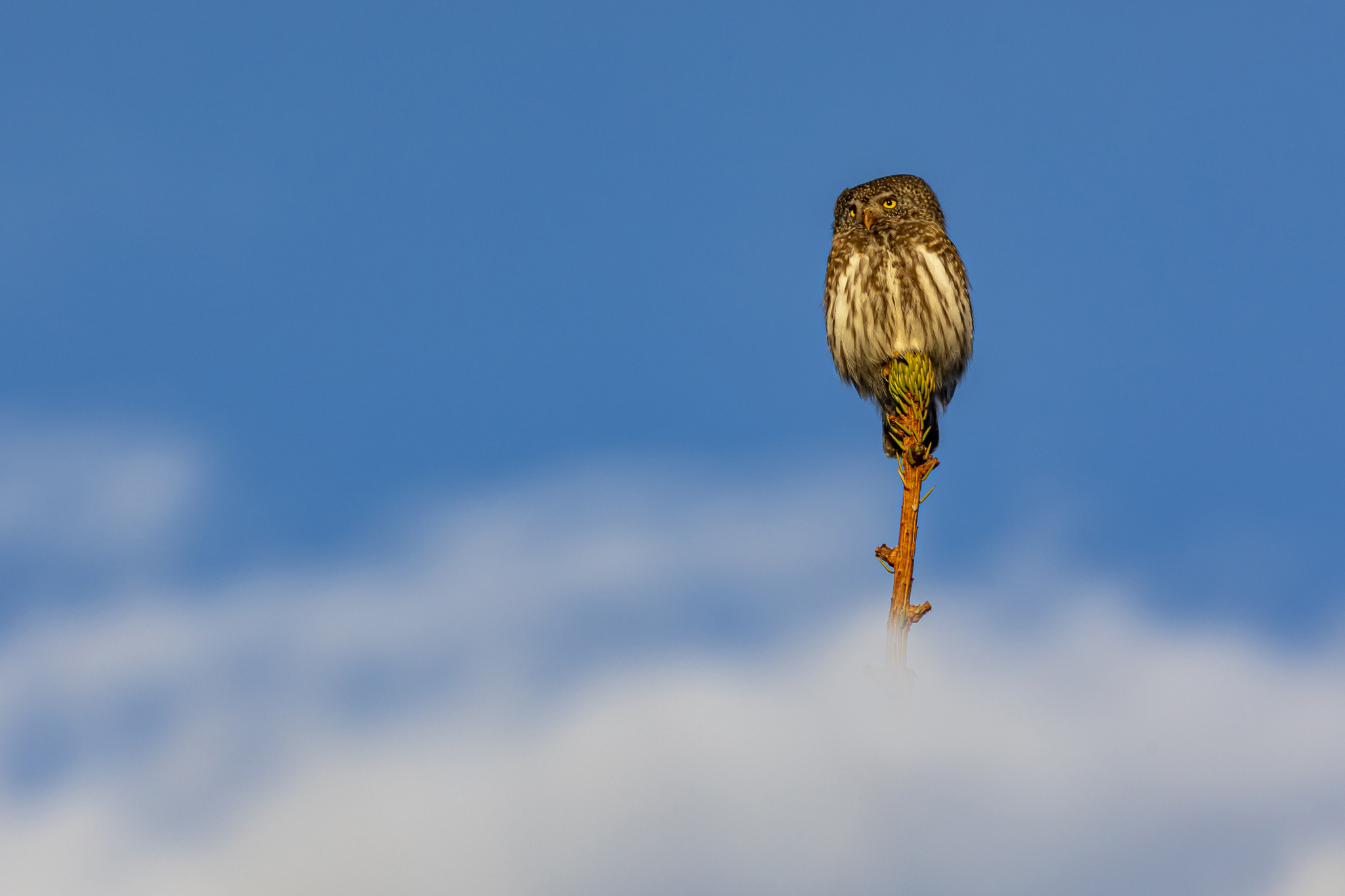The Eurasian Pygmy Owl (Glaucidium passerinum) is a small and elusive owl species found across Eurasia. Noted for its diminutive size and distinctive appearance, it is a fascinating bird of prey adapted to life in the dense forests of its range.
Description
- Size:
- Length: Approximately 14-17 centimeters (5.5-6.7 inches).
- Wingspan: About 30-35 centimeters (11.8-13.8 inches).
- Weight: Ranges from 60 to 100 grams (2.1-3.5 ounces).
- Appearance:
- Plumage: The Eurasian Pygmy Owl has a compact, rounded body covered in mottled brown and white feathers. Its plumage helps it blend into the forest canopy.
- Facial Disc: It has a distinctive facial disc with a pale center and dark rim, giving it an expressive face.
- Eyes: Large, yellow eyes provide excellent night vision, essential for hunting in low light.
- Beak: A small, yellow beak is adapted for catching small prey.
- Tail: The tail is short and squared off, aiding in maneuverability within dense foliage.
Habitat
- Distribution: The Eurasian Pygmy Owl is found throughout northern and central Eurasia. Its range includes Scandinavia, the Baltic States, northern Russia, and parts of Asia, extending into Japan.
- Preferred Environment: It inhabits dense coniferous and mixed forests, where it can find plenty of cover and hunting opportunities. It prefers forested areas with a good undergrowth.
Behavior and Ecology
- Feeding:
- Diet: The primary diet of the Eurasian Pygmy Owl consists of small mammals such as voles and shrews, insects, and small birds. It is known to hunt during both day and night, taking advantage of its excellent vision and stealthy hunting skills.
- Hunting Style: It hunts from a perch, waiting silently for prey to come into range before swooping down to catch it.
- Life Cycle:
- Breeding: Breeding season typically begins in late winter to early spring. The Eurasian Pygmy Owl nests in tree cavities or old nests of other birds. The female lays 3-6 eggs, which are incubated for about 25 days.
- Chicks: The chicks are altricial (born blind and helpless) and rely heavily on the parents for warmth and food. They fledge after about 4-5 weeks.
- Life Span: In the wild, the lifespan is generally around 2-5 years, though some individuals may live longer.
- Behavior:
- Activity: The Eurasian Pygmy Owl is mainly nocturnal but can also be active during the day, especially during dawn and dusk. It is known for its secretive nature and can be difficult to spot due to its camouflage and small size.
- Calls: It has a variety of vocalizations used for communication, including a distinctive trilling call that can be heard during the breeding season.
Conservation
- Status: The Eurasian Pygmy Owl is generally not considered endangered and is classified as Least Concern by the International Union for Conservation of Nature (IUCN). Its population is stable across much of its range.
- Conservation Efforts: While not currently threatened, maintaining healthy forest ecosystems is important for the conservation of this species. Habitat destruction and climate change could potentially impact its populations in the future.
Observing Eurasian Pygmy Owls
- Best Times: Best observed during the early morning or late afternoon, especially during the breeding season when they are more vocal.
- Watching Tips: Listen for their calls and look for them in dense forested areas where they can blend in with their surroundings. Their small size and secretive nature can make them challenging to spot.
Interesting Facts
- Size: Despite its small size, the Eurasian Pygmy Owl is a fierce hunter, capable of taking prey larger than itself.
- Camouflage: Its plumage is well-adapted for camouflage, allowing it to remain hidden from predators and prey alike.
Summary
The Eurasian Pygmy Owl (Glaucidium passerinum) is a tiny, elusive owl found in the forests of Eurasia. Known for its striking appearance and stealthy hunting skills, it occupies a niche in the forest ecosystem as a skilled predator of small mammals and insects. Its secretive behavior and effective camouflage make it a challenging yet fascinating bird to study and observe.
Visited 667 times, 8 visit(s) today
Views: 535
Subscribe to the newsletter:
